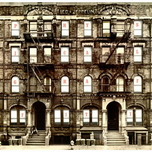|
Led Zeppelin returned from a nearly two-year hiatus in 1975 with Physical Graffiti, a sprawling, ambitious double album. Zeppelin treat many of the songs on Physical Graffiti as forays into individual styles, only occasionally synthesizing sounds, notably on the tense, Eastern-influenced "Kashmir." With John Paul Jones' galloping keyboard, "Trampled Underfoot" ranks as their funkiest metallic grind, while "Houses of the Holy" is as effervescent as pre- Beatles pop and "Down by the Seaside" is the closest they've come to country. Even the heavier blues -- the 11-minute "In My Time of Dying," the tightly wound "Custard Pie," and the monstrous epic "The Rover" -- are subtly shaded, even if they're thunderously loud. Most of these heavy rockers are isolated on the first album, with the second half of Physical Graffiti sounding a little like a scrap heap of experiments, jams, acoustic workouts, and neo-covers. This may not be as consistent as the first platter, but its quirks are entirely welcome, not just because they encompass the mean, decadent "Sick Again," but the heartbreaking "Ten Years Gone" and the utterly charming acoustic rock & roll of "Boogie With Stu" and "Black Country Woman." Yes, some of this could be labeled as filler, but like any great double album, its appeal lies in its great sprawl, since it captures elements of the band's personality rarely showcased elsewhere -- and even at its worst, Physical Graffiti towers above its hard rock peers of the mid-'70s.
|
